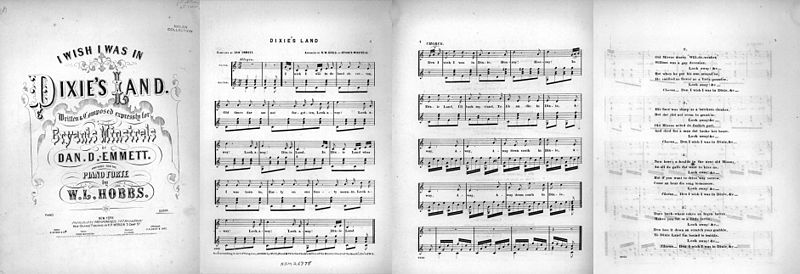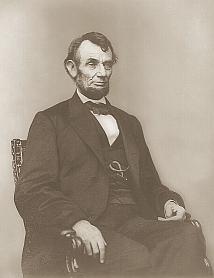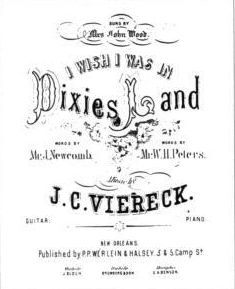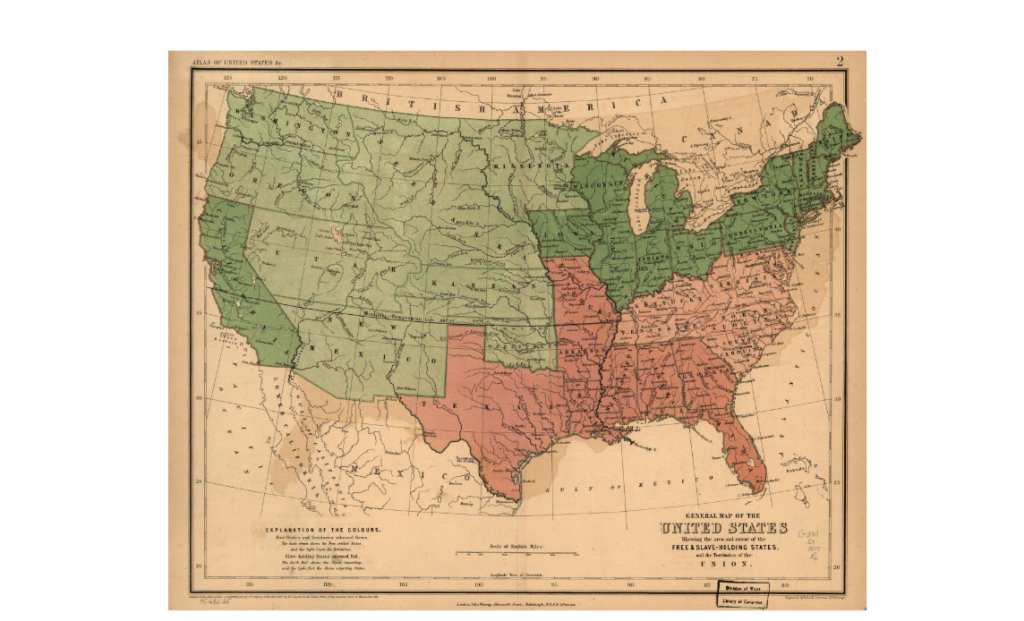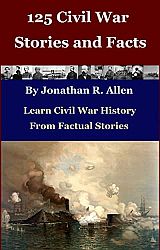The Song “Dixie” Was Popular In Both The North And The South
Abraham Lincoln Thought “Dixie” Was One Of The Best Tunes He’d Ever Heard
The song “Dixie” or “Dixie Land” or “I Wish I Was in Dixie,” was performed during Jefferson Davis’ inauguration as the provisional president of the Confederate States of America on February 18, 1861, in Montgomery, Alabama. Thereafter, it became the unofficial anthem of the South.
It’s accepted that Daniel Decatur Emmett wrote “Dixie.” There is some argument as to whether or not Emmet penned “Dixie” because others claimed credit for the song. Oddly, although “Dixie” became the Confederacy’s unofficial anthem, Emmett was a Northerner.
The South was particularly fond of “Dixie” before the Civil War, but it was a favorite of the North then too. With the coming of the Civil War, the bands of the Confederate armies made “Dixie” a major song in their repertoires. “Dixie” would get the Rebel soldiers’ feet tapping, and with certainty they would sing along as the band played. You can imagine the Southern pride of the Johnny Rebs rising, and their courage to face the next battle growing, as “Dixie” was played. Indeed, “In Dixie’s Land I’ll take my stand to live and die in Dixie.”
President Abraham Lincoln Liked The Song “Dixie”
A joyful crowd gathered outside the White House to celebrate the Union’s victory when the news reached the people of Washington, D.C. on April 10, 1865, of General Robert E. Lee’s surrender to General Ulysses S. Grant on April 9, 1865 at Appomattox Court House, Virginia. The celebration continued throughout the day and the people called and called for the president to make an appearance. Finally, President Abraham Lincoln came to speak to them from a window of the White House:
“FELLOW CITIZENS: I am very greatly rejoiced to find that an occasion has occurred so pleasurable that the people cannot restrain themselves. I suppose that arrangements are being made for some sort of a formal demonstration, this, or perhaps, to-morrow night. If there should be such a demonstration, I, of course, will be called upon to respond, and I shall have nothing to say if you dribble it all out of me before. I see you have a band of music with you. I propose closing up this interview by the band performing a particular tune which I will name. Before this is done, however, I wish to mention one or two little circumstances connected with it. I have always thought “Dixie” one of the best tunes I have ever heard. Our adversaries over the way attempted to appropriate it, but I insisted yesterday that we fairly captured it. I presented the question to the Attorney General, and he gave it as his legal opinion that it is our lawful prize. I now request the band to favor me with its performance.”
President Lincoln stood at the White House window enjoying “Dixie” as the band honored his request. Then the band followed with “Yankee Doodle.” At the end of “Yankee Doodle” Lincoln moved away from the window and the crowd soon dispersed.
Confederate “Dixie”
As performed by the 2nd South Carolina String Band.
The Confederate Lyrics For “Dixie”
Lyrics by Daniel Decatur Emmett.
Note: There are numerous variations and alternative verses.
I wish I was in the land of cotton,
Old times there are not forgotten;
Look away! Look away! Look away! Dixie Land.
In Dixie’s Land where I was born in,
Early on one frosty mornin,
Look away! Look away! Look away! Dixie Land.
I wish I was in Dixie, Hooray! Hooray!
In Dixie’s Land I’ll take my stand
to live and die in Dixie.
Away, away, away down south in Dixie.
Away, away, away down south in Dixie.
William was a gay deceiver;
Look away! Look away! Look away! Dixie Land.
And when he put his arms around ‘er,
He smiled as fierce as a forty-pounder,
Look away! Look away! Look away! Dixie Land.
I wish I was in Dixie, Hooray! Hooray!
In Dixie’s Land I’ll take my stand
to live and die in Dixie.
Away, away, away down south in Dixie.
Away, away, away down south in Dixie.
His face was sharp as a butcher’s cleaver
But that did not seem to grieve ‘er
Look away! Look away! Look away! Dixie Land.
Ole Missus acted the foolish part
She died for a man that broke her heart
Look away! Look away! Look away! Dixie Land.
I wish I was in Dixie, Hooray! Hooray!
In Dixie’s Land I’ll take my stand
to live and die in Dixie.
Away, away, away down south in Dixie.
Away, away, away down south in Dixie.
Now here’s to the health to the next ole Missus
An’ all the gals that want to kiss us;
Look away! Look away! Look away! Dixie Land
And if you want to drive away sorrow
Come and hear our song tomorrow
Look away! Look away! Look away! Dixie Land.
I wish I was in Dixie, Hooray! Hooray!
In Dixie’s Land I’ll take my stand
to live and die in Dixie.
Away, away, away down south in Dixie.
Away, away, away down south in Dixie.
Dar’s buckwheat cakes an Injun batter,
Makes your fat a little fatter;
Look away! Look away! Look away! Dixie Land.
Then hoe it down and scratch your gravel,
To Dixie’s Land I’m bound to travel.
Look away! Look away! Look away! Dixie Land.
I wish I was in Dixie, Hooray! Hooray!
In Dixie’s Land I’ll take my stand
to live and die in Dixie.
Away, away, away down south in Dixie.
Away, away, away down south in Dixie.
Union “Dixie”
Sung by Tennessee Ernie Ford.
The Union Lyrics For “Dixie”
The mocking lyrics of the Union version of the unofficial Confederate anthem, “Dixie.”
Away down South in the land of traitors,
Rattlesnakes and alligators,
Right away, come away, right away, come away.
Where cotton’s king and men are chattels,
Union boys will win the battles,
Right away, come away, right away, come away.
We’ll all go down to Dixie,
Away, away,
Each Dixie boy must understand
That he must mind his Uncle Sam,
Away, away,
We’ll all go down to Dixie.
Away, away,
We’ll all go down to Dixie.
I wish I was in Baltimore,
I’d make Secession traitors roar,
Right away, come away, right away, come away.
We’ll put the traitors all to rout.
I’ll bet my boots we’ll whip them out,
Right away, come away, right away, come away.
We’ll all go down to Dixie,
Away, away,
Each Dixie boy must understand
That he must mind his Uncle Sam,
Away, away,
We’ll all go down to Dixie.
Away, away,
We’ll all go down to Dixie.
Oh, may our Stars and Stripes still wave
Forever o’er the free and brave,
Right away, come away, right away, come away.
And let our motto ever be —
“For Union and for Liberty!”
Right away, come away, right away, come away.
We’ll all go down to Dixie,
Away, away,
Each Dixie boy must understand
That he must mind his Uncle Sam,
Away, away,
We’ll all go down to Dixie.
Away, away,
We’ll all go down to Dixie.

